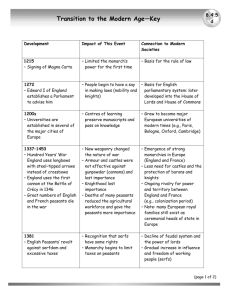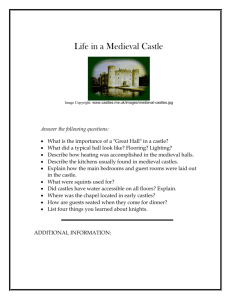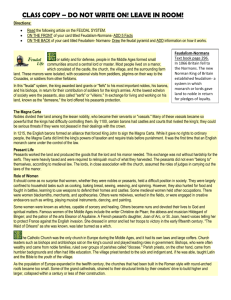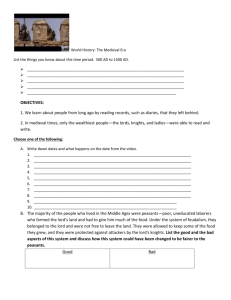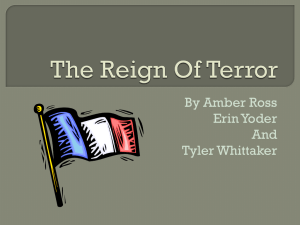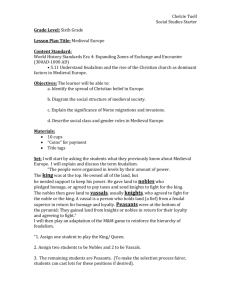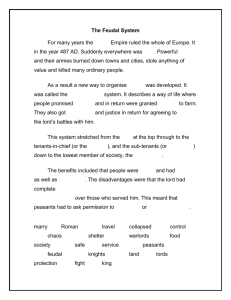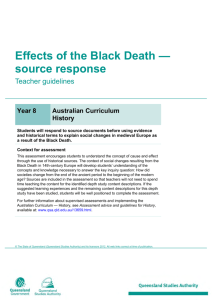Lesson Plan Day 2
advertisement
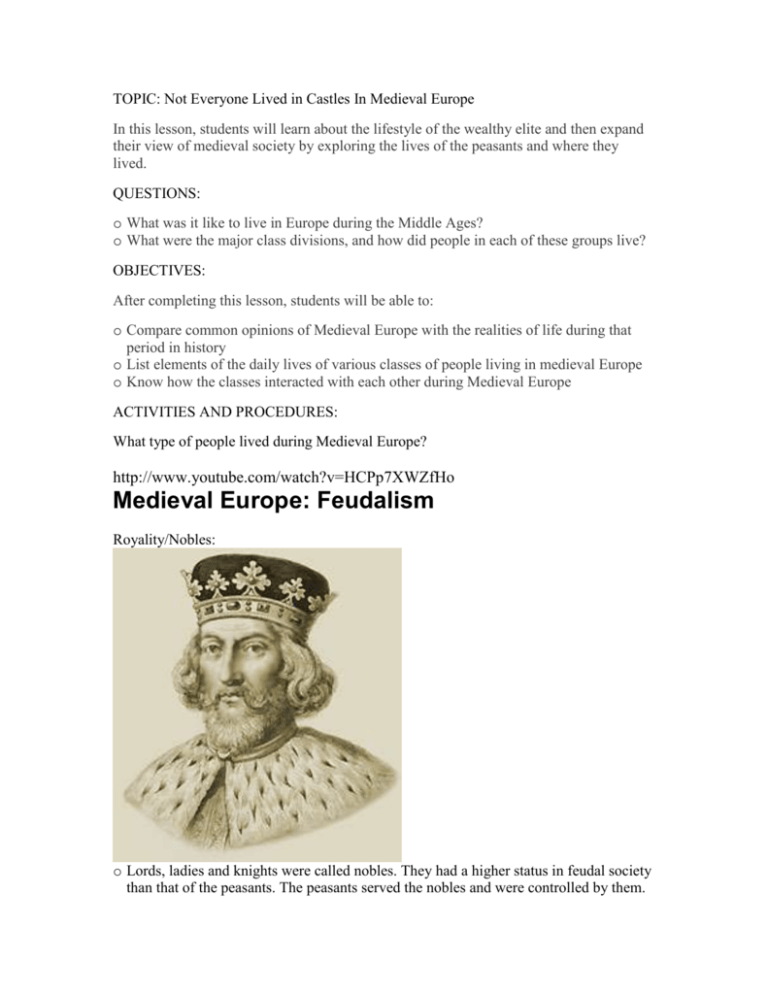
TOPIC: Not Everyone Lived in Castles In Medieval Europe In this lesson, students will learn about the lifestyle of the wealthy elite and then expand their view of medieval society by exploring the lives of the peasants and where they lived. QUESTIONS: o What was it like to live in Europe during the Middle Ages? o What were the major class divisions, and how did people in each of these groups live? OBJECTIVES: After completing this lesson, students will be able to: o Compare common opinions of Medieval Europe with the realities of life during that period in history o List elements of the daily lives of various classes of people living in medieval Europe o Know how the classes interacted with each other during Medieval Europe ACTIVITIES AND PROCEDURES: What type of people lived during Medieval Europe? http://www.youtube.com/watch?v=HCPp7XWZfHo Medieval Europe: Feudalism Royality/Nobles: o Lords, ladies and knights were called nobles. They had a higher status in feudal society than that of the peasants. The peasants served the nobles and were controlled by them. A lord had complete authority over his lands and the people who lived on his lands. o The Nobles lived in castles that were beautiful from the outside, but they were damp, smelly, and cold on the inside. Large stone castles were built in Europe from about the 1100’s to about the 1500’s. These huge buildings served not only to defend the country from foreign invaders but as the basic tool in preserving the king’s and the nobles’ power over the land. Castles were usually on high ground, which was generally not flat, and there were differing risks of attack from different directions. Meet the Commoners: o The peasants and craftsmen comprised the group known as the commoners or common people. o Medieval peasants had a difficult and often short life. They lived in one-room huts with dirt floors. These huts had no chimneys, which made them very cold in the winter. They had little or no furniture, and had to huddle together to keep warm. o Disease was common, and most peasants did not live beyond the age of 40. o Peasants lived in Cruck houses. These had a wooden frame onto which was plastered wattle and daub. This was a mixture of mud, straw and manure. The straw added insulation to the wall while the manure was considered good for binding the whole mixture together and giving it strength. The mixture was left to dry in the sun and formed what was a strong building material. o How did peasants in the middle ages interact with the other social classes? o In Europe, they were mostly based on lineage. It was extremely rare that a commoner or peasant would be able to gain nobility. Usually by serving a king, saving their life, etc. would be the only way a peasant would be able to gain nobility. Later nobility and titles could be bought for money, but they had to be maintained. Peasants would usually be kept illiterate while nobles would be able to get an education. The peasants interacted with the kings and queens because the peasants would work for them. Serfs were essentially peasants who lived on the land of rich nobles. These individuals would be assigned to a particular estate, farming for at least three days a week. The type of work and products were dictated by the lord of the estate. Serfs would pay to live on this land by providing rent in the form of money or surplus food. The life of a peasant was often harsh and difficult since they were at the bottom of the feudal system and strict social classes were in place. http://www.ehow.com/info_8528723_differentsocial-groups-medieval-times.html#ixzz2DZ3toMa7 EVALUATION AND ASSESSMENT Have the kids build a Medieval Castle using these websites: 1. The first website explains how to build the castle and what materials to use: http://www.yourchildlearns.com/megamaps/castle.html 2. The second website lets them build the castle interactively: http://www.highlightskids.com/games/build-castle 3. Have the student complete the maze and crossword for a fun homework assignment: o Websites to explore: o http://www.middle-ages.org.uk/daily-life-noble-lord-middle-ages.htm o http://westernreservepublicmedia.org/middleages/feud_nobles.htm o http://medievaleurope.mrdonn.org/nobility.html o http://www.historylearningsite.co.uk/medieval_peasants.htm o http://en.wikipedia.org/wiki/Peasant o http://www.middle-ages.org.uk/daily-life-peasant-middle-ages.htm o http://webtech.kennesaw.edu/jcheek3/castles.htm

